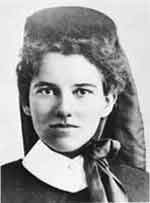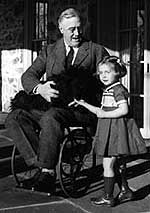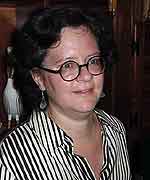By Dan Olson
Minnesota Public Radio
August 22, 2002
| |
|
|
|
||
Elizabeth Kenny grew up in rural Australia. She was the daughter of lower middle class Irish immigrant farmers. Medical doctors were scarce, and most health care was done by bush or rural nurses.
Yale University history professor Naomi Rogers says bush nurse Elizabeth Kenny tended to farm families scratching out a living in Australia's vast rural areas.
"She delivered babies, as did all bush nurses. She cared for young and sickly children, she examined women who lived in huts or shacks," Rogers said.
Rogers, also a native of Australia, is writing a book about Kenny. She said the young nurse went on horseback to many of her calls, but was impatient with the slow pace - so Kenny bought a motorcycle.
"She'd put her nurse's bag in the side pouch of the motorcycle, and roar off into the bush to see her patients," Rogers said.
There was little formal nurse training at the turn of the last century. Kenny found a doctor in her hometown who taught her some of the basics of medicine. She was a voracious reader, always borrowing books about the human body.
| |
|
|
|
||
Bush nursing was perfect for the independent-minded Kenny, Rogers said. There'd been a suitor or two, but she declined to follow her sister's example of marriage and homemaking.
"Kenny just never liked taking orders from anyone, and nursing was very appealing for a person of that character," Rogers said. "It was rare that there was much supervision, other than what the nurse herself determined was necessary."
Kenny first saw polio during Australia's epidemics in the early 1900s. A child she'd helped deliver a few years earlier came down with a fever, muscle pain and contortion that Kenny hadn't seen before. Kenny telegraphed her mentor physician and asked what she should do. He replied, "It sounds like polio - no known cure - treat the symptoms."
Strips of wool soaked in hot water became the basis for Kenny's therapy. Wrapping the hot strips around paralyzed limbs relieved the muscle pain. In England and the United States, doctors were putting polio victims in casts and braces. There was little or no thought to helping them regain use of their limbs.
But Australia was an ocean away. Word of the standard treatment hadn't reached the rural areas where Kenny worked. The heat relieved the muscle pain but didn't bring paralyzed limbs back to life. Kenny used her hands to search the victim's arms and legs for any sign of movement.
|
"Kenny just never liked taking orders from anyone, and nursing was very appealing for a person of that character."
- Yale University historian Naomi Rogers |
People attributed a healing touch to Kenny's hands. Richard Owen says what was really happening is Kenny's fingers detected faint muscle movement.
"She had a great sense of how to hold a paralyzed extremity and make you feel you were using it," he said.
By flexing polio victims' limbs, telling them to move it and then repeating the movement day after day, Kenny had hit upon a technique to jump-start a polio patient's brain.
"Your mind is remembering how you did something and it's sending down there, and the movement is sending messages back," Owen said.
Kenny said polio's paralysis was the result of "mental alienation," and she called her treatment "muscle re-education." Neither of those phrases - and others she coined - were in medical texts of the day. Kenny's jargon caused many in the medical establishment to dismiss her ideas.
World War I pushed worries about polio aside. The young Kenny signed up for England's nurse corps. She was given the military rank of Sister, recognizing that many of the nurses, but not Kenny, were from religious orders.
| |
|
|
|
||
After the war, Kenny resumed her polio treatment and her fame spread. She took letters of recommendation from Australian physicians to America.
World War II exploded as Kenny arrived in America. Polio was well known here, due in large measure to its best-known victim, President Franklin Roosevelt, who had been living with polio's effects for 20 years. He used a wheelchair, and metal braces helped him stand.
Roosevelt had become a potent fundraiser for research into a polio vaccine. However, an early vaccine was fatal, and Roosevelt pulled back on his support.
World War II's devastation eclipsed polio's rising toll. But anxiety over the spread of the disease was rising. Physicians and public health workers were virtually helpless to stave off polio's advance.
When Kenny arrived in 1940, she went to the American Medical Association. Yale University history professor Naomi Rogers said Kenny sought endorsement of her therapy from the AMA's director, but was rebuffed.
"(He) was very rude to her - something she would never forget - and treated her as an ignorant quack seeking money for her own gain," Rogers said.
Rogers says Kenny was dejected, tired and ready to return to Australia. She was on her way back to the West coast to board a ship home when she decided to stop at the Mayo Clinic in Rochester. Doctors there told her they had no polio patients and directed her to Minneapolis, one of the cities hardest-hit by the disease.
More from MPR


